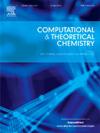Dopant-free hole transport materials for perovskite solar cells and donor molecules for organic solar cells
IF 3
3区 化学
Q3 CHEMISTRY, PHYSICAL
引用次数: 0
Abstract
This work aimed to create new Ullazine derivatives as hole-transporting materials (HTMs) for perovskite solar cells (PSCs) and donor materials for organic solar cells (OSCs). The newly devised compounds (UM1-UM6) exhibit much smaller energy band gaps and a broader λmax than the UMR because of their strong electron-attracting groups. While UMR has a bandgap of 3.37 eV, the produced molecules ranged from 1.45 to 2.08 eV. The λmax of UM1-UM6 in DCM are 376–460 nm, while the λmax value of UMR is 408 nm. The reference UMR has a λh value of 0.008164 eV, whereas the computationally computed λh values of the UM1-UM6 created molecules range from 0.003777 to 0.008791 eV. Reason being, the acceptor moieties of these compounds make hole transit easier. Furthermore, after all of the newly created molecules were scaled with a PC61BM acceptor, the Voc values were comparable to or higher than the reference, suggesting that these molecules are in a good position to increase efficiency. In terms of PCE (6.27 to 12.33 %), the newly created compounds (UM1-UM6) perform better than the reference compound (PCE = 7.80 %). The newly designed compounds (UM1-UM6) have the potential to be used as noble HTMs in the development of more advanced perovskite solar cells (PSCs) and donor molecules for organic solar cells (OSCs) in the future.

求助全文
约1分钟内获得全文
求助全文
来源期刊

Computational and Theoretical Chemistry
CHEMISTRY, PHYSICAL-
CiteScore
4.20
自引率
10.70%
发文量
331
审稿时长
31 days
期刊介绍:
Computational and Theoretical Chemistry publishes high quality, original reports of significance in computational and theoretical chemistry including those that deal with problems of structure, properties, energetics, weak interactions, reaction mechanisms, catalysis, and reaction rates involving atoms, molecules, clusters, surfaces, and bulk matter.
 求助内容:
求助内容: 应助结果提醒方式:
应助结果提醒方式:


